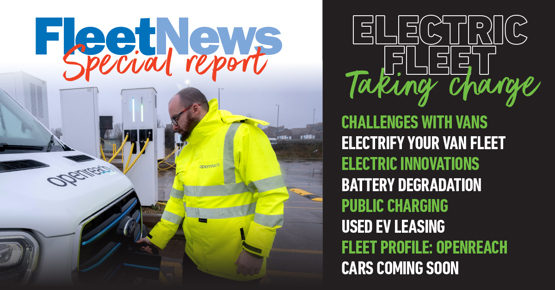This article has been taken from the latest Fleet News special report Electric Fleet: Taking Charge. It is sponsored by Allstar, Athlon, Northgate and Shell Fleet Solutions.

Battery degradation has long been the subject of many negative stories, fuelling fears over the longevity and long-term operational capability of electric vehicles.
My neighbour, for example, has been persuaded by the media he consumes that battery electric vehicles will need to be scrapped when they are seven or eight years old as their batteries will no longer be fit for purpose.
If true, this would have a significant impact for fleets – and for the wider EV sector as a whole – as the vehicles would not be desirable as long-term purchases.
After all, any drop in capacity means a comparable fall-off in range.
For example, if a battery degrades by 20%, then the distance that vehicle can travel between charges falls by a comparable amount.
For fleets, this could mean a vehicle that was fit for purpose when new, may not be suitable for the duty it was bought for just a handful of years later.
But analysis carried out by a number of fleet organisations and academics of many thousands of EVs shows these levels of degradation are not rooted in reality, with average degradation being around 1.8% a year.
“The fact is that a 1.8% decline in battery health is unlikely to have a significant impact on most drivers’ daily vehicle needs, and this number will only come down further with new EV models and improved battery technology,” says Aaron Jarvis, associate vice-president, sales and business development, UK & Ireland, at Geotab.
“People should feel confident that many current EVs are suitable and cost-effective to replace a range of light-, medium- and heavy-duty internal combustion engine (ICE) vehicles.”
Geotab has analysed the battery health of almost 5,000 fleet and private EVs, representing nearly 1.5 million days of telematics data, to explore how the latest battery technology holds up to the rigours of daily use.
The data highlighted how batteries degrade, on average, by 1.8% per year, compared with 2.3% when the company previously performed a wholesale analysis of EV battery health in 2019.
The best-performing EVs in the latest Geotab analysis posted a battery degradation of just 1%. Battery health testing company Generational has also seen, on average, degradation of 1.8% a year.
“That is, however, very much an average figure and there is quite a lot of variation across the board,” says Oliver Phillpott, CEO of Generational, a UK-based innovator in EV battery health certification.
He adds the results underline the urgent need for transparent, easy-to-understand information to be made available across the used vehicle market (see panel, below).
Progress in battery technology
Generational has also found that 2023 EVs maintain higher battery health on average than same-mileage 2016/17 models.
EVs from 2016-1017 had an average battery health of 76% at 90,000 miles, with 2023 vehicles recording an average of 86%.
“The results of our EV battery health testing highlights the remarkable progress in battery technology over recent years, and just how much more value it adds than the mileage figure when looking to acquire a used EV,” says Phillpott.
Potential contributors to why some vehicle models, on average, degrade faster than others are battery chemistry and thermal management of the battery pack.
While current EVs mostly use lithium-ion batteries, there are many different variations of lithium-ion chemistries and this will influence how it responds to stress.
Arval provides battery health certificates for its defleeted EVs and its analysis of 8,300 cars from 30 different brands sold in eight countries between March 2023 and November 2024 found the average battery health was 93% after 44,000 miles.
Almost all (98%) of the measured health statuses were above 80% and, on the vehicles travelling more than 120,000 miles, the battery health was close to 90% on average.
“With these higher levels of sustained health, batteries in the latest EV models will comfortably outlast the usable life of the vehicle and will likely not need to be replaced,” says Jarvis.
“However, we still see battery reliability being used as a stick to beat EVs with. Hopefully data such as ours can finally put these myths to bed.”
Loss of capacity is inevitable
Unfortunately, although the levels of degradation are much lower than is often portrayed, some loss of capacity is inevitable.
This is usually split into two mechanisms: calendar degradation which happens over the course of time and is unavoidable, and cycling ageing, which occurs as a result of the battery being charged and discharged.
Cycling ageing grows if operators increase the stress on batteries through regular rapid charging or deep discharges – charging the battery all the way up to 100% and discharging all the way down to near-empty before charging again.
Phillpott says this type of stress is reduced by modern battery management systems, but while these systems have certainly improved battery protection, the fundamental chemistry remains.
“Overall charge rates are generally increasing, and there’s currently a lot of discussion about megawatt charging – but we do have some reservations about what this unrelenting focus on speed will do to longevity,” he adds.
Scientists at America’s SLAC-Stanford Battery Center, a joint collaboration between Stanford University’s Precourt Institute for Energy and SLAC National Accelerator Laboratory, has carried out research into EV battery degradation, looking for differences in calendar and cycling degradation.
The research team tested 92 commercial lithium-ion batteries for more than two years across the discharge profiles.
“We battery engineers have assumed that cycle ageing is much more important than time-induced ageing,” says Alexis Geslin, a PhD student in materials science and engineering and in computer science in Stanford’s School of Engineering.
“That’s mostly true for commercial EVs such as buses and delivery vans that are almost always in use or being recharged.
“For consumers using their EVs to get to work, pick up their kids, go to the grocery store, but mostly not using them or even charging them, time becomes the predominant cause of ageing over cycling.”
Minimising degradation
However, while some degradation is unavoidable, fleet operators can adopt certain best practices to minimise it.
“First, pay attention to the state-of-charge window used,” says Phillpott. “Avoid leaving vehicles parked at 100% charge and only charge to the level you need.
“Keeping an average charge level around 50% is better than 80%. Smart charging helps with this by ensuring vehicles reach the right charge level exactly when needed.
“Second, be mindful of charging power. Limit rapid charging where possible, though operational needs will often dictate this.
“Train your drivers to use regenerative braking and to drive pre-emptively and smoothly to reduce battery stress.”
Phillpott says lastly – and where possible – avoid deep discharge cycles.
However, this can be the most challenging thing to implement, and very much depends on operational requirements.
“Taken together, these changes can add up to significant improvements in longevity if they can fit around your business needs,” adds Phillpott.
Call for battery health certificates
Calls continue for an industry-backed health certificate for electric vehicles, to boost consumer confidence and improve residual values.
The Association of Fleet Professionals (AFP) and many other bodies signed a British Vehicle Leasing and Rental Association (BVRLA) open letter in April which called for a battery health certificate scheme among other measures.
“There is a huge amount of misinformation about EV batteries, ranging from their supposed propensity to self-combust to the speed at which they degrade,” says Ric Baird, board member at the AFP.
“However, all the available evidence now shows them to be stable, robust and long-lasting, with degradation generally occurring at a slow and predictable rate. That needs to be communicated.”
Research from insurers AXA UK shows that battery health certificates could play a significant role in stimulating the UK’s used EV market by providing a measure for vehicle value that does not currently exist.
Its report ‘Sparking Change – the case for delivering EV battery health certificates’ highlights the benefits of standardised battery health certificates in increasing demand for used EVs and alleviating consumer concerns.
The certificates, it says, would provide consistency in battery health information for all makes and models of used EVs to give consumers more confidence in the longevity of the vehicles they are buying.
“This also has the potential to positively impact insurance premiums by providing a barometer for assessing the value of EVs in a similar way that mileage is used for vehicles with an engine,” says Marco Distefano, managing director of AXA Retail.
With the ban on the sale new petrol or diesel vehicles just one or two replacement cycles away, transitioning to an electric fleet is at the top of the agenda for the majority of fleet decision-makers.
But the switch to the zero-emission technology is fraught with obstacles – especially for van operators who face legislative issues as well as vehicle suitability and charging.
In our new Electric Fleet: Taking Charge report, we look in detail about how you can start the journey to van electrification and speak to those already well advanced in their transition about the innovative ways in which they overcome some of the problems.
Employing industry experts and scientific research, we also bust some myths about batteries – spoiler alert, the average level of degradation at 1.8% a year is much lower than many predicted – and look at the technologies poised to come to market promising greater range and faster charging.
The report is sponsored by Allstar, Athlon, Northgate and Shell Fleet Solutions.






